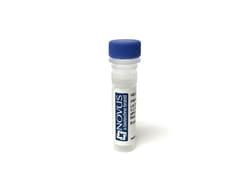FoxP3 Antibody (FXP3/197), DyLight 550, Novus Biologicals™
Manufacturer: Novus Biologicals
Select a Size
| Pack Size | SKU | Availability | Price |
|---|---|---|---|
| Each of 1 | NBP234620R-Each-of-1 | In Stock | ₹ 58,562.00 |
NBP234620R - Each of 1
In Stock
Quantity
1
Base Price: ₹ 58,562.00
GST (18%): ₹ 10,541.16
Total Price: ₹ 69,103.16
Antigen
FoxP3
Classification
Monoclonal
Conjugate
DyLight 550
Gene Alias
AIID, AIIDMGC141961, DIETER, forkhead box P3, Forkhead Box Protein P3, FOXP3delta7, immune dysregulation, polyendocrinopathy, enteropathy, X-linked, Immunodeficiency, Polyendocrinopathy, Enteropathy, X-Linked, IPEX, JM2, MGC141961, MGC141963, PIDX, PIDXMGC141963, Scurfin, XPID, XPIDpolyendocrinopathy, enteropathy, X-linked
Host Species
Mouse
Molecular Weight of Antigen
51 kDa
Quantity
0.1 mL
Research Discipline
Adaptive Immunity, Cell Biology, Chromatin Research, Immunology, Transcription Factors and Regulators
Gene ID (Entrez)
50943
Target Species
Human, Mouse, Primate
Form
Purified
Applications
Flow Cytometry, ELISA, Immunohistochemistry, Immunocytochemistry, Immunofluorescence, Immunohistochemistry (Paraffin), Immunohistochemistry (Frozen)
Clone
FXP3/197
Dilution
Flow Cytometry, ELISA, Immunohistochemistry, Immunocytochemistry/Immunofluorescence, Immunohistochemistry-Paraffin, Immunohistochemistry-Frozen
Gene Symbols
FOXP3
Immunogen
Recombinant human full-length FoxP3 protein (Uniprot: Q9ZS1)
Purification Method
Protein A or G purified
Regulatory Status
RUO
Primary or Secondary
Primary
Test Specificity
Recognizes a protein of 47-55kDa, which is identified as FOXP3. Its precise epitope is not known, but it has been mapped to the N-terminal portion of the protein. The FOX family of transcription factors is a large group of proteins that share a common DNA binding domain termed a winged-helix or forkhead domain. During early development, FOXP1 and FOXP2 are expressed abundantly in the lung, with lower levels of expression in neural, intestinal and cardiovascular tissues, where they act as transcription repressors. FOXP1 is widely expressed in adult tissues, while neoplastic cells often exhibit a dramatic change in expression level or localization of FOXP1. Mutations in FOXP3 gene cause IPEX, a fatal, X-linked inherited disorder characterized by immune dysregulation. The FOXP3 protein is essential for normal immune homeostasis. Specifically, FOXP3 represses transcription through a DNA binding forkhead domain, thereby regulating T cell activation.
Content And Storage
Store at 4C in the dark.
Isotype
IgG1 κ
Description
- FoxP3 Monoclonal specifically detects FoxP3 in Human, Mouse, Monkey samples
- It is validated for Western Blot, Flow Cytometry, Immunohistochemistry, Immunohistochemistry-Paraffin.

